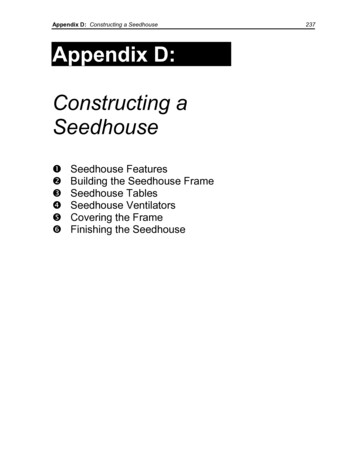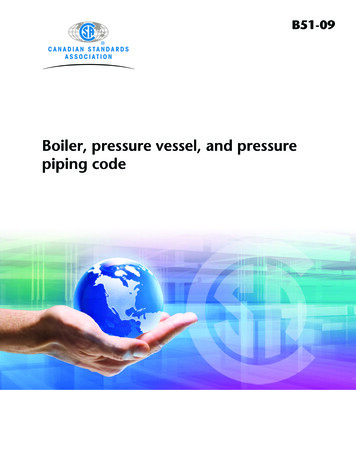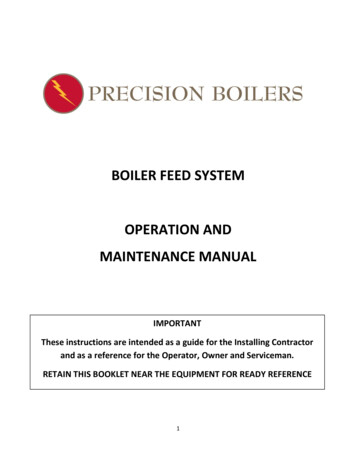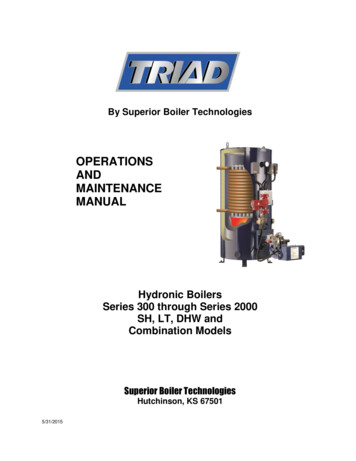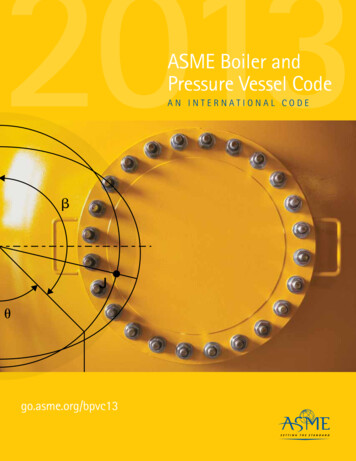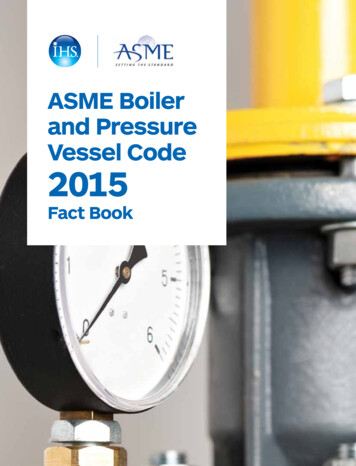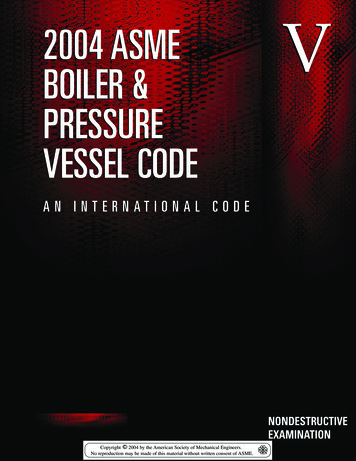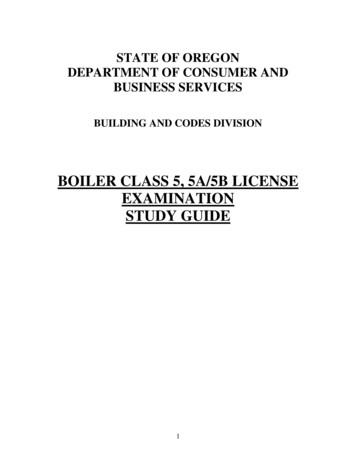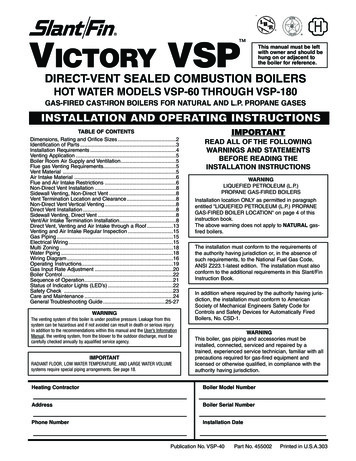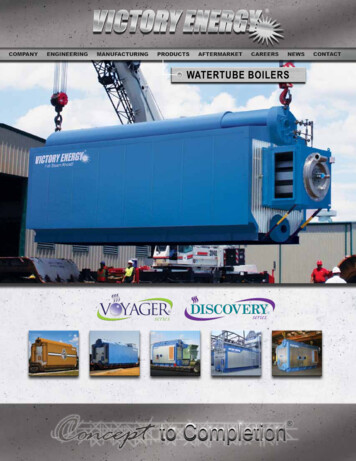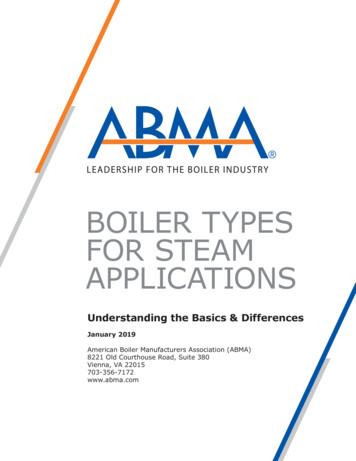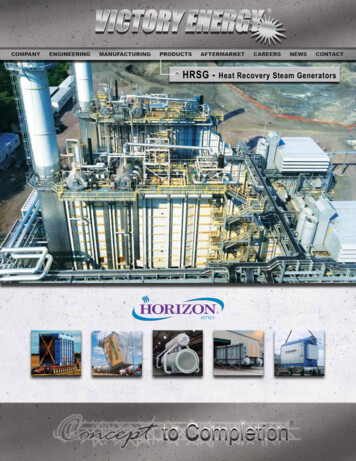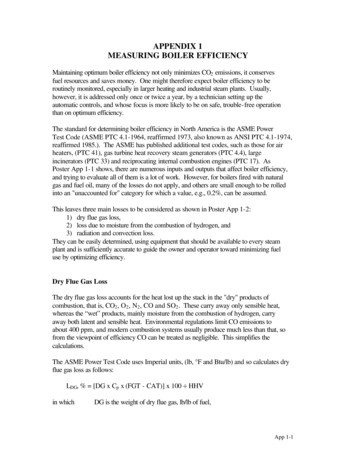
Transcription
APPENDIX 1MEASURING BOILER EFFICIENCYMaintaining optimum boiler efficiency not only minimizes CO2 emissions, it conservesfuel resources and saves money. One might therefore expect boiler efficiency to beroutinely monitored, especially in larger heating and industrial steam plants. Usually,however, it is addressed only once or twice a year, by a technician setting up theautomatic controls, and whose focus is more likely to be on safe, trouble-free operationthan on optimum efficiency.The standard for determining boiler efficiency in North America is the ASME PowerTest Code (ASME PTC 4.1-1964, reaffirmed 1973, also known as ANSI PTC 4.1-1974,reaffirmed 1985.). The ASME has published additional test codes, such as those for airheaters, (PTC 41), gas turbine heat recovery steam generators (PTC 4.4), largeincinerators (PTC 33) and reciprocating internal combustion engines (PTC 17). AsPoster App 1-1 shows, there are numerous inputs and outputs that affect boiler efficiency,and trying to evaluate all of them is a lot of work. However, for boilers fired with naturalgas and fuel oil, many of the losses do not apply, and others are small enough to be rolledinto an "unaccounted for" category for which a value, e.g., 0.2%, can be assumed.This leaves three main losses to be considered as shown in Poster App 1-2:1) dry flue gas loss,2) loss due to moisture from the combustion of hydrogen, and3) radiation and convection loss.They can be easily determined, using equipment that should be available to every steamplant and is sufficiently accurate to guide the owner and operator toward minimizing fueluse by optimizing efficiency.Dry Flue Gas LossThe dry flue gas loss accounts for the heat lost up the stack in the "dry" products ofcombustion, that is, CO2 , O2 , N2 , CO and SO2 . These carry away only sensible heat,whereas the “wet” products, mainly moisture from the combustion of hydrogen, carryaway both latent and sensible heat. Environmental regulations limit CO emissions toabout 400 ppm, and modern combustion systems usually produce much less than that, sofrom the viewpoint of efficiency CO can be treated as negligible. This simplifies thecalculations.The ASME Power Test Code uses Imperial units, (lb, F and Btu/lb) and so calculates dryflue gas loss as follows:LDG, % [DG x Cp x (FGT - CAT)] x 100 HHVin whichDG is the weight of dry flue gas, lb/lb of fuel,App 1-1
Poster App 1-1ASME Boiler EfficiencyApp 1-2
Cp is the specific heat of flue gas, usually assumed to be 0.24,FGT is the flue gas temperature, F,CAT is the combustion air temperature, F,HHV is the higher heating value of the fuel, Btu/lb.The formula can be simplified toLDG, % [24 x DG x (FGT - CAT)] HHVIf temperatures are measured in C, other units remaining unchanged, the formulabecomesLDG [43.2 x DG x (FGT - CAT)] HHVThe weight of dry gas per lb of fuel, DG, varies with fuel composition and the amount ofexcess air used for combustion. For the normal case of no CO or unburned hydrocarbonsit can be calculated as follows:DG, lb/lb fuel (11CO2 8O2 7N2 ) x (C 0.375S) 3CO2in whichCO2 and O2 are % by volume in the flue gas,N2 is % by volume in the flue gas, 100 - CO2 - O2 ,C and S are weight fractions from the fuel analysis, that is, lb/lb fuelIt is important to note that the foregoing equation requires the flue gas analysis to bereported on the dry basis; that is, the volumes of CO2 and O2 are calculated as apercentage of the dry flue gas volume, excluding any water vapour. This is because earlygas analysis techniques employed wet chemistry, which condensed the water vapour inthe process of taking the sample. Many modern analytical techniques, such as thoseemploying infrared or paramagnetic principles, also measure on a dry gas basis becausethey require moisture-free samples to avoid damage to the detection cells. Theseanalyzers are set up with a sample conditioning system that removes moisture from thegas sample. However, some analyzers, such as in-situ oxygen detectors employing azirconium oxide cell, measure on the wet gas basis. Results from such equipment need tobe corrected to a dry gas basis before they are used in the ASME equations. This iseasily done using correction factors as follows:%, dry basis %, wet basis x FApproximate values for F, suitable for quick assessment of boiler efficiency, areNatural gas: F 1.19No. 2 oil:F 1.12No. 4 oil:F 1.10For more precise work, F can be selected from Table App 1-1.App 1-3
Poster App 1-2Simplified Boiler EfficiencyApp 1-4
Table App 1-1Wet Gas MeasuredCO2 or O2%1234567891011121314Factors to Convert Wet Gas Analyses to Dry Gas Basis*Natural .141.131.12-Correction Factor FNo. 2 .101.101.091.081.07-No. 4 101.091.091.081.071.07-*As an example: A natural gas fired boiler’s flue gas was measured on a wet basisto be 6% O2 and 9% CO2 , the corrections would be:% O2 , dry basis %, wet basis x F 6% x 1.15 6.9%% CO2 , dry basis %, wet basis x F 9% x 1.22 10.98%So to determine dry flue gas loss, one needs: Measurements of flue gas temperature and combustion air temperature, which are partof the normal complement of instrumentation, or can be readily determined. Flue gas analysis for CO2 and O2 , which can be determined by a portable flue gasanalyzer with an appropriate water trap in the sampling system. Some plants havecontinuous gas analyzers in place. Fuel analysis and heating value. Typical values are shown in Table App 1-2. Thecomposition of No. 6 oil is more variable than the others, particularly with respect tosulphur and fuel-bound nitrogen, so the values in Table App 1-2 should be viewed asindicative only. It is better to have an analysis performed on a representative sampleof the oil delivered to the plant.One can see from the equations that the quantity of dry gas, DG, can be reduced byreducing the amount of oxygen in the flue gas, that is, by reducing the excess air.Reducing DG in turn reduces the dry flue gas loss, LDG. One can also see that reducingthe difference between the flue gas temperature FGT and combustion air temperature,CAT, the reference temperature for determining boiler efficiency, can reduce LDG.App 1-5
Preheating the combustion air, raising the CAT, and installing an economizer to recoverheat from the flue gases, lower the FGT, can reduce this difference.Table App 1-2Typical Analyses for Common Fossil FuelsFuelNatural GasHHV, Btu/lb22,450No. 2 Oil(light oil)19,450No. 4 Oil(bunker A)18,750No. 6 Oil(bunker C)18,350Ultimate analysis, weight gen6lb CO2 /10 BtuinputIt is not obvious from the formula for LDG that reducing the quantity of dry flue gas DGalso reduces the flue gas temperature. However, considering that a boiler represents afixed heat exchange area, it is understandable that reducing the gas flow over that surfacetends to reduce the final temperature of the gas. Thus, reducing excess air has acompounded favourable effect on boiler efficiency, and maintaining close control overexcess air is the best opportunity for improving boiler efficiency. Excessive emission ofCO and unburned hydrocarbons, and unsafe boiler operation are factors that limit theextent to which excess air can be reduced. Good burners and precise combustion controlsare necessary for good results.Loss Due to Moisture from the Combustion of HydrogenAs explained in Chapter 3, the hydrogen component of fuel leaves the boiler as watervapour, taking with it the enthalpy, or heat content, corresponding to its conditions oftemperature and pressure. It is steam at very low pressure but fairly high temperature, thestack temperature, and most of its enthalpy is in the heat of vapourization. This makes ita significant loss, commonly about 11% for natural gas and 7% for fuel oil. Thedifference reflects the relative hydrogen content of these two fuels.The ASME Power Test Code formula for calculating the loss due to moisture from thecombustion of hydrogen is:LH, % [900 x H2 x (hg – hf)] HHVin whichH2 is the weight fraction of hydrogen in the ultimate analysis of the fuel,App 1-6
HHV is the higher heating value,hg is the enthalpy in Btu/lb of water vapour at 1 psi and the flue gastemperature (FGT) in F, andhf is the enthalpy of water at the combustion air temperature (CAT) in F.hg can be determined from steam tables or from the equationhg , Btu/lb 1055 (0.467 x FGT).hf can also be determined from steam tables, or from the simple relationshiphf , Btu/lb CAT - 32.So, knowing the flue gas temperature, combustion air temperature and fuel analyticaldata, LH can be readily calculated. Unfortunately, there is not much the operator can doto reduce it. Since most of the lost heat is in the heat of vapourization, measures thatreduce the flue gas temperature have only a small effect. One measure, particularlyeffective when firing natural gas, is to pass the flue gas through a condensing heatexchanger, which recovers the heat of vapourization by converting the water vapour backto liquid form. This method requires additional equipment and is discussed in Chapters 2and 3.Loss Due to Radiation and ConvectionThe nature and extent of the loss due to radiation and convection (LR) are discussed inChapter 3. LR is not normally measured; instead it is estimated using a chart prepared bythe American Boiler Manufacturers’ Association (ABMA). Values applicable to modernboilers having all walls watercooled have been selected from the ABMA chart and arepresented in Figure App 1-1.Figure App 1-1Radiation and Convection Losses for Various Boiler SizesApp 1-7
As pointed out in Chapter 3, LR can be minimized by distributing demand among theavailable boilers to keep those in operation in the upper load range. Also, the lost heatusually warms up the boiler room, sometimes uncomfortably so, and sometimes it ispractical to recover some of this heat by extending the forced draft fan intake to near theceiling. This raises the combustion air temperature (CAT) and somewhat reduces the dryflue gas loss (LDG). However, if this is done the effects on fan capacity and boiler roomventilation should be checked.“Unaccounted-For” LossesAs indicated in Poster App 1-2, reasonable assumptions concerning these losses are 0.1%for natural gas, 0.2% for light oil. For heavy oil, a value between 0.3 and 0.5% may beappropriate, to account for fuel heating and, perhaps, atomizing steam. Plants burningsolid fuels require individual assessment to address the additional losses such as carbonin ash.Using Boiler Efficiency DataHaving determined flue gas analysis, flue gas temperature and combustion airtemperature for each boiler at perhaps four or five points over its load range, the operatorcan then make use of this data to optimize plant performance. First, by looking at O2 andCO levels in the flue gas, conclusions can be drawn about the adjustment of the air/fuelcontrols, and whether dry flue gas loss (LDG) can be safely reduced by reducing excessair. Second, boiler efficiency at each test point can be obtained by adding up the losses,as determined from the foregoing procedures, and subtracting from 100. That is;Efficiency (ηη ) 100 – (LDG LH LR LUA)Then an efficiency curve can be drawn for each boiler. Usually boiler efficiency ishighest somewhere between 50% and 80% of maximum capacity rating (MCR). It isgenerally lower at low load due to higher excess air and higher radiation and convectionlosses, and lower at high load due to high stack temperature. With the boiler efficiencycurves as a guide the operator can shift loads between boilers to maintain each at close toits highest efficiency. In designing or refurbishing a plant, the profile of demand versustime should be carefully considered, and boiler sizes should be selected so that theyoperate in the most efficient range most of the time.If existing boilers have a high stack temperature at full load, and operate there much ofthe time, it might be cost effective to add heat recovery equipment such as economizersor air heaters.App 1-8
The standard for determining boiler efficiency in North America is the ASME Power Test Code (ASME PTC 4.1-1964, reaffirmed 1973, also known as ANSI PTC 4.1-1974, reaffirmed 1985.). The ASME has published additional test codes, such as those for air heaters, (PTC 41), gas turbine heat recovery steam generators (PTC 4.4), large
